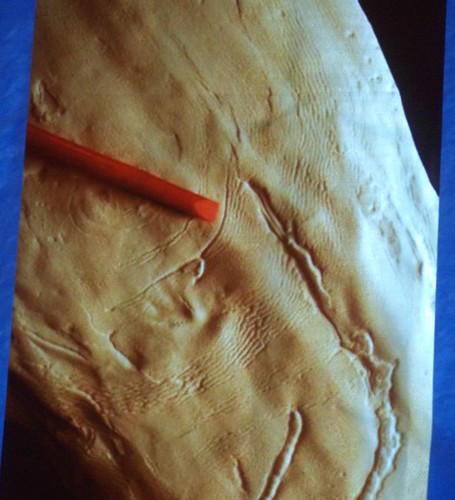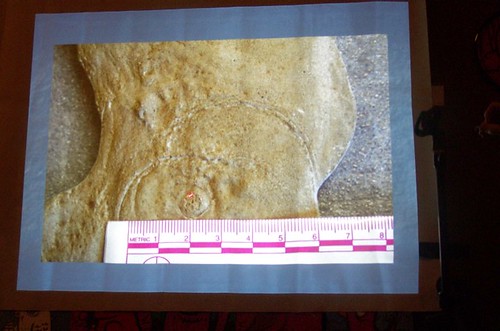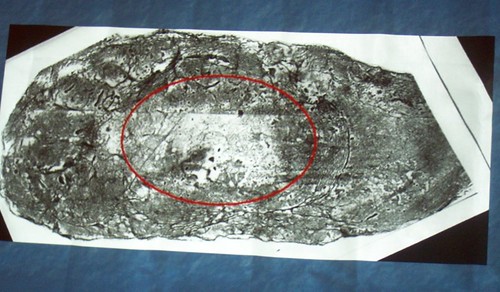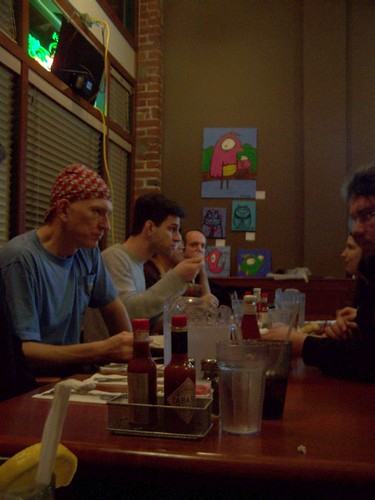` And who is Matt Crowley? He's worked much of his life as both a pharmacist and a Jim Rose Circus sideshow performer called 'The Tube' -- although I highly doubt that he has ever entertained customers at the pharmacy by putting a condom into his mouth and pulling it out of his nose.
` If you would like to see some of Matt's abilities, including his vomit-inducing 'tube' act, I will not ruin this post with it until near the end. All I can say is, I'm glad I didn't see that just before eating some delicious fish tacos while sitting right across from him.
Besides his stomach-churning creativity, Matt is also a man of great non-freak ingenuity, a man who apparently invented the duct tape wallet (technically, it was gaffer tape) when on the road with Soundgarden at Lollapalooza in 1992 (daaarn yooou, Chris Cornell!), and here he is showing us folks his most awesome toolbelt gadgets -- a 'hidey hole', and also a really cool Swiss Army Knife-type thing:
(Apologies to that guy in the corner, whose name I keep forgetting, which I also apologize for.) [It's JC.] One of the other members (I keep forgetting her name, too) asked, "Is this craft time with Matt Crowley?" It indeed was -- he also showed us a key pouch he had made from fabric used by firefighters, as well as his glorious red polypropylene wallet.
He also used to make and sell lamps with Kevlar fiber shades. (And as The Tube knows, Kevlar is also good for keeping your chest safe when exploding firecrackers on it.)
The ironic thing is, I did not know that Matt was one of our group members, but I had heard an interview with him on an episode of Monster Talk, where he discussed such side show props as the Minnesota Ice Man and the people who make them.
` Speaking of items which have been examined and even considered as possibly real by some bigfoot researchers, I will save the rest of the conversations (as well as the opening media humor) until the end of this post and get on with the main attraction already:
This post, since I know it will take way too long to write, will not really add to/critique Matt's presentation, but I will include links to pages of his own website, Orgone Reseach, so that you can see more details at your own leisure.
Important to this story is Jimmy Chilcutt (who I ironically have some familiarity with from another episode of Monster Talk), who is a retired fingerprint expert, not only in humans but in great apes and monkeys.
` He claims that the ridges he's examined on some so-called Sasquatch tracks are dermal ridges, as seen in one's hand- or footprints, especially because of the distortions of what appear to be scars. For reference, Crowley shows us the Chilcutt segments of the documentary Sasquatch: Legend Meets Science.
So, Crowley began with the question; can dermal ridges be captured in fine sediment? He pressed his foot into a box filled with fly ash and found that when he filled it with cement, it produced a cast that was complete with his own dermal ridges, including his toe-prints. The same worked with pumice, which is sold as "Volcanic Ash" at Seattle Pottery Supply.
` Interestingly, there were also some quite large ridges running the length of his footprint which are very unusual, as the dermal ridges on human feet are horizontal. Similarly, the lines that Chilcutt had noticed on alleged bigfoot tracks are both vertical and twice as large as human dermal ridges.
` Does this mean that Crowley is secretly part bigfoot?
No: In fact, these vertical ridges are not found on his foot at all! He even made an impression of a perfectly smooth plastic plank, which also revealed "dermal ridges"! Crowley found this phenomenon in tracks he made in other substrates, including calcined kaolin and clay-like soil from the Duwamish river. Not surprisingly, he also found it when he used silica, which one might expect to find on Onion Mountan, which is the place where Chilcutt's "best" cast seems to have been taken.
` Interestingly, Chilcutt claims that this cast is from Blue Creek Mountain Road, and also claims that it is the original. However, when Crowley came to see the Blue Creek casts, their owner Jeff Meldrum said that they are certainly originals (and seem to be complete with the original substrate stuck to their surfaces), but that they came from Onion Mountain, and are clearly labeled as such.
` The cast that Chilcutt claims is the "best" is the one marked CA-19, yet he never refers to this number. Even stranger, the man who actually took the Onion Mountain casts, John Green, claims that at one point he had run out of storage space for casts and "did not keep that one".
` What does this even mean? Well, if it is the original, then Chilcutt has to explain why he doesn't seem to know what it's called, but if it isn't, then these wouldn't be the original ridges anyway! In any case, some sort of incompetence or other seems to be at work.
This photo, as I recall, is one of Crowley's experiments that show how the cast records the point of where the plaster is poured, creating little ripples as it flows outwards:
Geologist Anton Wroblewski has coined the term 'dessication ridges' for this phenomenon, and they look just like the ridges described by Chilcutt. Not only that, but the dessication ridges are usually accompanied by arched furrows, also found in the Onion Mountain trackway.
` Also interestingly, the Onion Mountain track, CA-19, which you can see many photos of here, was used twice in the documentary Legend Meets Science, once in the Chilcutt segment, and another time in the Skookum cast segment (which is clearly the shape of an elk lying down in the mud).
Matt has also found that using a fixative, such as hair spray, indeed does prevent dessication ridges from forming. Chilcutt may have known to use fixative when making casts, but he said that he did not know these ridges would occur if he didn't.
` Also, the flow pattern of the dessication ridges also depends on the shape of the track, and this is found with all the materials that Crowley has used.
So, since you can get dessication ridges on a cast of just about anything, what was making the tracks?
` The Blue Creek--Onion Mountain tracks very much resemble the non-symmetrical wooden prosthetic feet of prolific bigfoot storyteller and footprint hoaxer Ray Wallace (here displayed by Wallace's nephew).
Starting in the 1950's, back when the idea of Sasquatch was just spreading to the United States, Wallace had claimed that a similar creature was what had made the footprints found around sites where he worked in logging and road construction. He was also the first to call it "bigfoot".
Wallace was known to have worked on Onion Mountain at the time the tracks were found, and the fact that there is an exaggerated protrusion on the left track just as there is with the left prosthetic, as well as a crack in the right track, which looks like the crack on the right prosthetic, suggests that these were his handiwork.
` Also, the fact that wooden prosthetics would be completely rigid means that they would leave very deep imprints of the toes, but not at the ball of the foot, and have other such features that are found in Wallace's footprint casts.
` Not only do they lack definition or flexion in the ball of the foot, they show no sign that the ball of the foot was used in propelling the 'bigfoot' forward, which is a clear and obvious feature in human footprints.
Crowley presented his findings at a Bellingham bigfoot conference in 2005 and was approached by Jeff Meldrum, who said (to paraphrase), "Don't be so tentative with your conclusion; that's a slam dunk!" That's because, unbeknownst to Crowley, Meldrum had independently discovered the phenomenon of dessication ridges himself, using Idaho loess soil.
` So, here's an example of concentric dessication ridges:
And here's an actual inked print of the 'dermal ridges' from an alleged 'bigfoot' print -- see how both of them ripple outwards from central points?
In some of the tracks, the outline of the foot and the contours of the toes are not very distinct, and have a bloblike appearance, yet the ridges are perfectly clear -- as with the track CA-20, which actually has a ridge going straight across the vague indentations made by the toes.
` Meldrum and Chilcutt don't actually claim this track's ridges are from bigfoot, rather than dessication, yet the ridges are very similar to those of CA-19.
` Although Chilcutt has argued that dermal ridges have round peaks while dessication ridges are flat on top, Crowley has also found that in fact dessication ridges often are rounded, and that they only flatten where the substrate is pushed down the hardest.
` And, as for what appears to be scarring on the "Wrinkle Foot" track, similar marks can be made by a suction effect, as Brenden Banner found when he stamped a rubber "monster foot" in mud. Since there is at least one other possibility, a scar is evidently not the only explanation.
Dr. Wroblewski agrees, and thinks that some other examples of bigfoot dermal ridges are due to dessication ridges. After all this examination, how could it not be obvious to everyone? Also, Crowley's research has been replicated (on the internet, at least) by others, notably bigfoot advocate Sam Rich, who agrees with Matt's conclusion.
` As a side note of interest, he's also found that dessication ridges that look a lot like large finger prints can be created by putting a little dish detergent in the cement.
On top of all this, although apes in zoos have distinct dermal ridges on their feet, they also have thick creases and cracks, and in the wild they often have even rougher feet, as well as sores and ulcerations. Why, if dermal ridges are found, would such heavier features not be even more obvious?
` The same goes for humans who don't wear shoes; the bottoms of their feet are like leather and often deeply cracked, with flexion ridges where the foot bends. One would expect this from something that similarly doesn't wear shoes.
I don't remember him mentioning the Squatchopedia's initial reaction to this and Melisssa Hovey (and her insanity), but as I was perusing Matt's blog posts, I found these things also to be entertaining.

Anyway, that was basically how Matt Crowley's slide presentation of Bigfootprinty Doom has come across to me, and it has inspired me to actually do something researchy myself. What that researchy thing may be, I don't know yet, but surely something will come to mind any day now.
Afterwards, he was awarded with these very delicious Mystery Mints, which come in a Ouija Board-patterned tin, as well as a bottle of Holy Land lotion. And he earned every bit of them!
As for the remainder of this post, I will reproduce the rest of what I recall from our meeting:
Back to the time before Matt's presentation, there was a lively conversation at our table, involving Steph, from New York, who was telling us about his 7 years doing this Korean massage that involves "chi". Eventually, he began to see that what really seems to be going on here is the benefits of massage plus placebo and the proprioception-related illusion that energy is coming from one's hands. Occam's Razor at work!
` The new girl, Heidi, who is really cool and into dragon boating, was asking Steph whether some physical therapy technique was evidence-based. Also, she wrote an article that's coming out in the next issue of Skeptic magazine about her adventures in sleep paralysis! (OMG, I could have done the same thing and never thought of it!) Also, we ordered two different types of tacos so that we could each trade one -- because we're just that special!
Also, Matt asked me where my namesake Spoony Quine comes from, and had guessed that I got it from the Soundgarden song Spoon Man, and from Willard Van Orman Quine. Come to think of it... kinda! I did have spoon-playing in mind when I thought it up, and I did look up the name 'Quine' to see if it was even a real name, and found the philosopher to be rather impressive enough to use it with confidence.
` But, before even that, I had spelled 'Quine' phonetically, as 'Kwayn', but then, people pronounced it 'Kwein', and actually spelled it 'Kwane'! So, I conventionalized the spelling so that people could clearly see that it was supposed to rhyme with 'vine' -- and yet, most people have pronounced it 'Quinn'! ARRGH!
` Despite my hearing other skeptics pronouncing it it correctly, this fact didn't really strike me until both Matt and Heidi said to me, "You must be Spoony Quine!" and I was like, "Wow, you got it right!" Then again, I should not be surprised -- we skeptics are generally a literate bunch!
Another point of interest; as a kid, Matt remembers being exposed to Jack Chick's creationist 'Big Daddy' tract as a kid, and he knew just enough about science to find it questionable. Now that I've found it online, I am planning to do a parody of it, where the teacher presents what evolution actually is instead of the 'creationist version' of evolution!
` That, I guarantee, would be worth something!
And, as you'll remember, I said that I would show you all what Matt used to be up to before he got into such things as amateur bigfoot track research. Can you believe he used to superglue a bowling ball to his hand, and even more crazy and painful-looking things, including his "gavage" act, which involves a tube with a plunger device that he hand-made himself.
` Ah, the sideshow. There's really nothing like it. This, my friend, takes talent! Also lots of practice.
I can't stop watching, even though I want to hurl! It's like an amusement park ride that I don't wanna get off of!!! (Who knows? I'd probably actually wind up drinking it, if given the chance!)
` Even weirder, when I was a severely abused and depressed teenager, I used to watch The X-Files, which was the first time I ever took notice of this other sideshow performer called Enigma who I called "The Puzzle Piece Guy". I would often fantasize about running off to the circus with him, to be with the other freaks.
` It turns out that he was actually one of the people that Matt "The Tube" had performed with -- here they are during a rather long tour of Europe:
And to think that just last month I inadvertently took a picture of Matt and didn't realize who he was! (The picture is supposed to signify how close I was sitting to Jen MeCreight, the BlagHag, who's on the right.)
Now, this month, in the time between our tabley conversations and Matt's presentation, the first part of 'the show' began with Case's usual hilarity of funny photos (i.e. a protestor with a sign that says "Destroy the Computer!" and it is not hand-written: Another was a totaled car whose license plate says "God is my co-pilot"), an article ("Smoking is not the worst possible health choice", with other options including shooting yourself and drinking molten gold), comics (i.e. someone pointing to the word EVOL_T_ON and saying "That can't possibly be 'Evolution'; there are too many gaps!" and another saying, "That must mean the answer is 'Creation'."), a KOMO 4 News segment (Cosmetic Acupuncture? REALLY?!?!), and the prospect of signing up for the World Telekinesis Competition, which involves getting a candle to melt the most wax on your side, apparently in good fun rather than seriousness.
And let's not forget the fact that Climate Gate is really just a media phenomenon -- Rachel Maddow does a hilarious reporting job of this: (Also, notice the text that reads 'Flimmaker'! Ha!)
And, for pure entertainment purposes, the Colbert Report's take on William Tapley and his phallic, karaoke conspiracy theory about the Denver International Airport signalling the end of the world:
| The Colbert Report | Mon - Thurs 11:30pm / 10:30c |
| Mysteries of the Ancient Unknown - 2012 End of Times | |
| Colbert Report Full Episodes | Political Humor & Satire Blog | Video Archive |
Case also showed us part of the Frontline investigation of Fukushima disaster -- it's an hour long, so we didn't watch much of it, but we did have a discussion. You can see that investigation here, at the PBS website.
I also particularly liked this 'Science' motivational poster he had, so let me stick that here:

Very pithy. And that is my twisted, first-last-middle, upside-down, round-and-round post. I bet it kinda makes you want to get off now, doesn't it?
` And as my brain has fried, it's time for bed. I've had a very long day, even though it did not even involve making up for the fact that no one has shown up for Lou Ryan's garden work party this week. (At least he got the neighbor boys to pick up river rocks up out of the grass for 2 cents a pebble!)
In fact, this post was late in coming because I must have spent 20 hours just cleaning my office, which involved going through many stacks of paper, as well as rearranging all my shelves! I can guarantee you it is now quite tidy and relatively dust-free, and now my office is perfect... for getting on with my plans!
Yes, my plans. You know, my plans!!!
Until next time... stay sick! Turn blue! Climb walls! And don't explode firecrackers on your chest without Kevlar!








No comments:
Post a Comment
I want to know what you're thinking! Please tell me -- you don't need to sign up, just go!